NADIA: Secret of the Blue Water [1989]
Flash Gordon
(Anime Corner Staff Writer)
Pioneer Elite Plasma Display System PDP-5050SX
Denon AV Surround Receiver AVR-1801 with Dolby Digital/ DTS
Boston Acoustics Micro90T Die-Cast Surround Speakers including Subwoofer
Toshiba DVD SD-3755 Player with Dolby Digital/ DTS/ 3D Surround Sound.
SERIES [39 EPISODES] / MOTION PICTURE
12+ RATING
C+ ANIMATION
A- CHARACTER
A- MECH/ CREATURE DESIGN
B- MUSIC
B- STORY
B- SERIES GRADE
STUDIO: GAINAX
DIRECTOR: HIDEAKI ANNO/ VARIOUS
PRODUCER: KENICHI MARUYAMA/ HIROSHI KUBOTA/ TOHO/ KORAD
ANIMATOR: HIDEAKI ANNO/ SHUNJI SUZUKI
DESIGNS: YOSHIYUKI SADAMOTO [character]/ HIDEAKI ANNO [mechanical]
SCRIPT: HISAO OKAWA
MUSIC: SHIRO SAGISU
THEME SONG: ‘BLUE WATER’ [opening theme] YOSHIMASA INOUE featuring MIHO MORIKAWA
‘YES, I WILL…’ [closing theme] JOE RINOIE featuring MIHO MORIKAWA
DVD EXTRAS: NADIA TRAILERS/ VOLUME PREVIEWS/ CHARACTER PROFILES/ VOICE ACTRESS INTERVIEW/ VOICE ACTOR INTERVIEW/ CAST INTERVIEWS
|
| REVIEW (Warning:
Spoilers Ahead!) |
“Do you want to know the secret?”
A visit to a Boston anime shop prompted the exchange, “Gainax is impressive. I like them because they are willing to take risks.” Indeed. While Nadia: The Secret Of Blue Water [Fushigi No Umi No Nadia in Japan]  may not hold a candle to the highly original Neon Genesis Evangelion [NGE] or be as nearly tripped out as FLCL, it did recycle many anime ideas into a fairly compelling and comprehensive saga. But, Gainax did make a huge leap of faith in fronting a series with an African character. Introducing a gorgeous, non-Anglo female lead may not have been the most groundbreaking move in anime [she could have been green and fans would have adored her], but it was one more notch in an already impressive line of risk-taking for the always left of center, adventure studio Gainax. Studio head Hideaki Anno did indicate later it was the color palette for lighter tones that made it easier for the animator to animate and generate clearly visible facial expressions. If Nadia were too dark it would have been problematic to the viewer. One more visit to a comic shop prompted a different kind of debate. “I don’t like animation where the characters never blink their eyes.” I wasn’t about to tussle with the local comic store geek, but I was close. Otaku are well aware budgetary limitations exact shortcutting in cel animation, but I’m here to confirm Nadia blinks. She blinks, big eye blinks and she’s beautiful. Sorry, I never liked that kid anyway.
may not hold a candle to the highly original Neon Genesis Evangelion [NGE] or be as nearly tripped out as FLCL, it did recycle many anime ideas into a fairly compelling and comprehensive saga. But, Gainax did make a huge leap of faith in fronting a series with an African character. Introducing a gorgeous, non-Anglo female lead may not have been the most groundbreaking move in anime [she could have been green and fans would have adored her], but it was one more notch in an already impressive line of risk-taking for the always left of center, adventure studio Gainax. Studio head Hideaki Anno did indicate later it was the color palette for lighter tones that made it easier for the animator to animate and generate clearly visible facial expressions. If Nadia were too dark it would have been problematic to the viewer. One more visit to a comic shop prompted a different kind of debate. “I don’t like animation where the characters never blink their eyes.” I wasn’t about to tussle with the local comic store geek, but I was close. Otaku are well aware budgetary limitations exact shortcutting in cel animation, but I’m here to confirm Nadia blinks. She blinks, big eye blinks and she’s beautiful. Sorry, I never liked that kid anyway.
Before there was the dark, epic struggle that would be NGE, Gainax was busy sharpening its animation style and storytelling skills with other titles, Gunbuster [1988], Royal Space Force: Wings Of Honneamise [1987] and the fantasy adventure Nadia: The Secret Of Blue Water [1989] [Nadia]. The initial idea for Nadia actually bore fruit from the mind of director Hayao Miyazaki. Miyazaki originally re-imagined Jules Verne’s
Around The World In 80 Days, but left the concept in development hell while employed with Toho in the 1970s. Toho retained the rights. Those elements later re-emerged in part as Miyazaki’s own Laputa: Castle In The Sky [1986], but more 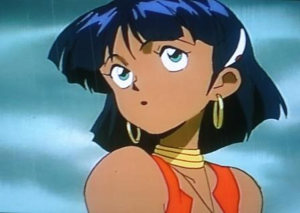 importantly in keeping with the original spirit of those ideas as Nadia when Toho approached and tapped its two greatest advocates Hideaki Anno and Yoshiyuki Sadamoto, the heart of Gainax. The studio’s reputation was already being fortified thanks to its earlier aforementioned productions and Toho hoped to implement their high standards to the series. The staggering 39-episode extravaganza engaged viewer’s hearts until the grand finale. Unlike the shadowy world of NGE, Nadia is certainly lighter and more accessible in its presentation with those rare, menacing moments hinting of things to come via the experimental studio bubbling under the show’s surface. In fact, Anno conceded years later, in retrospect, they would have preferred to flesh out the much darker tones of the series for an older audience. It certainly lends credence to the evolution of the resulting NGE. As it stands, Nadia is a delightful journey for all ages. For the older set, when things get dark it never gets dark enough, but kids will revel in a world of adventure and excitement populated by colorful characters pursued by the evil Gargoyle. Watching it with young kids I found it struck a fine balance between emotional and substantive without breaching the graphic or disturbing. Still, director Hideaki Anno keeps things eventful with occasional fan service.
importantly in keeping with the original spirit of those ideas as Nadia when Toho approached and tapped its two greatest advocates Hideaki Anno and Yoshiyuki Sadamoto, the heart of Gainax. The studio’s reputation was already being fortified thanks to its earlier aforementioned productions and Toho hoped to implement their high standards to the series. The staggering 39-episode extravaganza engaged viewer’s hearts until the grand finale. Unlike the shadowy world of NGE, Nadia is certainly lighter and more accessible in its presentation with those rare, menacing moments hinting of things to come via the experimental studio bubbling under the show’s surface. In fact, Anno conceded years later, in retrospect, they would have preferred to flesh out the much darker tones of the series for an older audience. It certainly lends credence to the evolution of the resulting NGE. As it stands, Nadia is a delightful journey for all ages. For the older set, when things get dark it never gets dark enough, but kids will revel in a world of adventure and excitement populated by colorful characters pursued by the evil Gargoyle. Watching it with young kids I found it struck a fine balance between emotional and substantive without breaching the graphic or disturbing. Still, director Hideaki Anno keeps things eventful with occasional fan service.
Eventually, Miyazaki implemented his version of those initial designs for his second feature film under the Studio Ghibli banner in the form of Laputa: Castle In The Sky. Meanwhile, Anno took the basic written premise and ran with it for his own incarnation resulting in Nadia. Miyazaki’s influence on the concept is
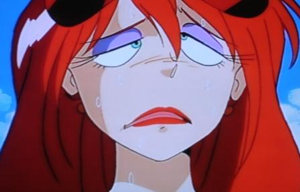 apparent and explains why this sometimes-fanciful outing may be the most un-Gainax of the bunch. Nevertheless, Gainax makes its presence felt. Both projects offer remarkably similar results demonstrating they sprung to life from the same source. Certainly each is painted with original flourishes in telling the director’s stories. Both are thoughtful; Miyazaki’s flavor is more traditionally fantastical while Anno’s taste tends to be moodier in tone. The dark undercurrents of Nadia are mindfully kept in check, as the show was immensely popular with the young in Japan upon its arrival. Anno doesn’t exactly play it safe and breezy, but never pushes the boundaries of nudity or violence. Gainax would push the envelope of expectations with the sinister tour de force that would be NGE.
apparent and explains why this sometimes-fanciful outing may be the most un-Gainax of the bunch. Nevertheless, Gainax makes its presence felt. Both projects offer remarkably similar results demonstrating they sprung to life from the same source. Certainly each is painted with original flourishes in telling the director’s stories. Both are thoughtful; Miyazaki’s flavor is more traditionally fantastical while Anno’s taste tends to be moodier in tone. The dark undercurrents of Nadia are mindfully kept in check, as the show was immensely popular with the young in Japan upon its arrival. Anno doesn’t exactly play it safe and breezy, but never pushes the boundaries of nudity or violence. Gainax would push the envelope of expectations with the sinister tour de force that would be NGE.
Here is a synopsis of the similarities and differences between Nadia and
Laputa:
-
Nadia: The Secret Of Blue Water
/ Laputa: Castle In The Sky
-
Nadia is an orphan Sheeta is an orphan
-
Nadia controls a Blue Water [crystal amulet] Sheeta controls a blue crystal amulet
-
Nadia is befriended by a charming boy named Jean Sheeta is befriended by a charming boy named Pazu
-
The Grandis Gang desires Nadia’s Blue Water The Dola Gang desires Sheeta’s amulet
-
The Grandis Gang is not the real enemy The Dola Gang is not the real enemy
-
Nadia’s Blue Water has mystical powers Sheeta’s amulet has mystical powers
-
Nadia utilizes Blue Water for good Sheeta utilizes the amulet for good
-
Gargoyle is the real enemy Muska is the real enemy
-
Nadia is the descendant of a lost civilization Sheeta is the descendant of lost civilization
-
The lost civilization of
Atlan/ Tartesos is discovered The lost civilization of Laputa is discovered
-
Floating island in the sea Floating island in the sky
Despite flaws and a clearly over ambitious agenda, Nadia is compelling serial entertainment, especially for kids. The series was often sold as based loosely [and we use that term loosely] on elements from 20,000
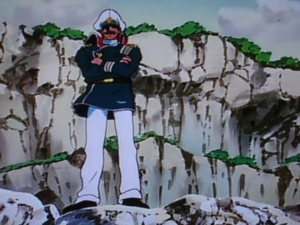 Leagues Under The Sea. The fact is Anno is clearly a fan of Jules Verne, as the story plays fast and loose with a number of Verne stories. Jules Verne’s 20,000 Leagues Under The Sea [the Giant Squid, the Nautilus, Nemo] is reflected. There are elements from Verne’s Around The World In 80 Days, The Mysterious Island [Jean and Nadia’s pre-Survivor-like, pre-Lost-styled episodes on Lincoln Island] and even Five Weeks In A Balloon [life in a floating Gratan], but again loose is the operative word here. Homage aside, Anno was clearly an original, a genius, the real deal in the making based on his design work for Miyazaki’s Nausicaä Of The Valley Of The Wind [1984]. When fan boy studio Gainax was formed, the studio proved its visionary direction on the historic direct-to-video OVA Gunbuster. Royal Air Force: Wings of Honneamise further proved it could muscle powerful storytelling. Nadia simply demonstrated it could go the distance with a comprehensive, long-running TV series filled with charm and vitality. This was simply the next step in confirming its heavyweight status within the industry.
Leagues Under The Sea. The fact is Anno is clearly a fan of Jules Verne, as the story plays fast and loose with a number of Verne stories. Jules Verne’s 20,000 Leagues Under The Sea [the Giant Squid, the Nautilus, Nemo] is reflected. There are elements from Verne’s Around The World In 80 Days, The Mysterious Island [Jean and Nadia’s pre-Survivor-like, pre-Lost-styled episodes on Lincoln Island] and even Five Weeks In A Balloon [life in a floating Gratan], but again loose is the operative word here. Homage aside, Anno was clearly an original, a genius, the real deal in the making based on his design work for Miyazaki’s Nausicaä Of The Valley Of The Wind [1984]. When fan boy studio Gainax was formed, the studio proved its visionary direction on the historic direct-to-video OVA Gunbuster. Royal Air Force: Wings of Honneamise further proved it could muscle powerful storytelling. Nadia simply demonstrated it could go the distance with a comprehensive, long-running TV series filled with charm and vitality. This was simply the next step in confirming its heavyweight status within the industry.
While illumination on NGE requires a collegiate level textbook, Nadia is far less complex. It’s the ride getting there that’s fun for most. In 39 episodes, Gainax single-handedly takes the viewer around the world, under the sea, into the skies and somehow comes to a more traditionally satisfying conclusion than the 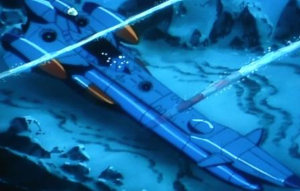 much maligned and wronged NGE. Nadia was originally slated to be a leaner, more streamlined 26 episode series before the Japanese public devoured it with glee. Truth be told, the creative staff and resulting series would have benefited significantly with a tighter plan. Spread too thin some episodes suffer from fewer animation cels and the storyline meanders aimlessly at times, particularly on the island where it digresses from the point of the story, the secret of Blue Water. Some argue it is pivotal to the development of the relationship between Nadia and Jean, while a strong editor could have worked wonders. Nadia was so well received producers were hard-pressed to extend the adventure to its detriment with fairly spontaneous filler. The series suffers from this production decision and it is one that deserved a better fate had sharper pencils prevailed. Nadia is populated with some of anime’s most endearing and charming characters for their heroics and human frailties. There is a timeless quality to the series despite animation that is at times rushed. This is pure, ‘classic’ anime straight up sans today’s computer trickery. The story is a plethora of clichéd and original ideas amalgamated into a cohesive whole with the fresh vitality of Gainax behind the driver’s seat. Gainax’ attention to detail on the vast array of colorful characters and dynamic relationships has built a fan following. The adoration continues for this series today.
much maligned and wronged NGE. Nadia was originally slated to be a leaner, more streamlined 26 episode series before the Japanese public devoured it with glee. Truth be told, the creative staff and resulting series would have benefited significantly with a tighter plan. Spread too thin some episodes suffer from fewer animation cels and the storyline meanders aimlessly at times, particularly on the island where it digresses from the point of the story, the secret of Blue Water. Some argue it is pivotal to the development of the relationship between Nadia and Jean, while a strong editor could have worked wonders. Nadia was so well received producers were hard-pressed to extend the adventure to its detriment with fairly spontaneous filler. The series suffers from this production decision and it is one that deserved a better fate had sharper pencils prevailed. Nadia is populated with some of anime’s most endearing and charming characters for their heroics and human frailties. There is a timeless quality to the series despite animation that is at times rushed. This is pure, ‘classic’ anime straight up sans today’s computer trickery. The story is a plethora of clichéd and original ideas amalgamated into a cohesive whole with the fresh vitality of Gainax behind the driver’s seat. Gainax’ attention to detail on the vast array of colorful characters and dynamic relationships has built a fan following. The adoration continues for this series today.
Our voyage begins with the Paris World Exposition [1889] in France and the confluence of events that lead to the introduction of Nadia, Jean and King who unite for their global adventure. The Nadia series is a clever mixture of science fiction and fantasy adventure. The key players are both fourteen-year-old orphans radically opposite in their cultural blends of wide-eyed, optimistic and sweet innocence. There is French lad Jean Coq de Raltique, the prodigy-like inventor-hero and technophile. The beautiful Nadia of Africa is the pessimistic, sometimes explosively hot-tempered,
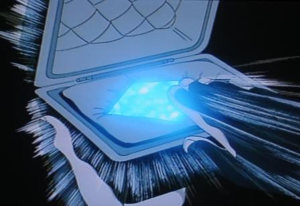 strong-willed, independently courageous, always moody object of Jean’s desires. Where Jean is open to new ideas and new people, Nadia is guarded, skeptical and closed with a distrust of others. [In fact, I’ll go so far as to say there are times when she is downright unlikable, utterly impossible, out of her freaking mind, but that’s me -ed]. There is comic relief thanks to delightful sidekick King, Nadia’s young lion cub; complete with a hysterical set of obviously bulging little testicles. King represents Nadia’s strong affection for all animal life. Throughout the series Nadia actively presents a Gandhi-like voice of non-violence. She staunchly believes in the simplicity of the natural world, whereby Jean symbolizes modernization and solution through technology. The contrast leads to much conflict and puppy love styled sexual tension as well as balance or ying yang. Together, on their journey, the threesome tackles life and death struggles and personal discovery [making the long haul home for Rudolph and Yukon Cornelius against the Abominable look like a walk in the proverbial park -ed]. Other radiant personalities to populate the Nadia-verse include the wise, sturdy, stubborn and mysterious Captain Nemo and his stunning, blonde first lady officer, the eloquent Electra. Nemo is the charismatic helmer of the sleek and powerful Nautilus submarine, fully weapon loaded and built from state-of-the-art Atlantean technology. Nemo and company’s home base, the South Pole, is reachable through a vast network of undersea tunnels. The engine itself is the infatuation of Jean. The ship is slightly reminiscent of the popular Space Battleship Yamato [aka Star Blazers] and less like the source material from which it takes its name. Nadia and Jean meet young Marie also orphaned following the cold-blooded murder of her parents. She comes under Nadia and Jean’s wing as a kind of surrogate child. The jewel-thieving trio of the not-so-evil and often silly Grandis Gang eventually befriends the others injecting comic relief along the way. The group is comprised of attractive, fiery, redhead Grandis Granva and bodyguards Sanson [the brawn] and Hanson [the brains]. Hanson is the ingenious inventor-extraordinaire and designer of the super-mecha vehicle Grandis Tank aka The Gratan. The Gratan, like the Nautilus, is a unique character in and of itself. It transitions between aircraft with propellers to underwater submersible to boat to battle tank with extendable arms complete with an array of weaponry to behold. Inevitably all join forces to
strong-willed, independently courageous, always moody object of Jean’s desires. Where Jean is open to new ideas and new people, Nadia is guarded, skeptical and closed with a distrust of others. [In fact, I’ll go so far as to say there are times when she is downright unlikable, utterly impossible, out of her freaking mind, but that’s me -ed]. There is comic relief thanks to delightful sidekick King, Nadia’s young lion cub; complete with a hysterical set of obviously bulging little testicles. King represents Nadia’s strong affection for all animal life. Throughout the series Nadia actively presents a Gandhi-like voice of non-violence. She staunchly believes in the simplicity of the natural world, whereby Jean symbolizes modernization and solution through technology. The contrast leads to much conflict and puppy love styled sexual tension as well as balance or ying yang. Together, on their journey, the threesome tackles life and death struggles and personal discovery [making the long haul home for Rudolph and Yukon Cornelius against the Abominable look like a walk in the proverbial park -ed]. Other radiant personalities to populate the Nadia-verse include the wise, sturdy, stubborn and mysterious Captain Nemo and his stunning, blonde first lady officer, the eloquent Electra. Nemo is the charismatic helmer of the sleek and powerful Nautilus submarine, fully weapon loaded and built from state-of-the-art Atlantean technology. Nemo and company’s home base, the South Pole, is reachable through a vast network of undersea tunnels. The engine itself is the infatuation of Jean. The ship is slightly reminiscent of the popular Space Battleship Yamato [aka Star Blazers] and less like the source material from which it takes its name. Nadia and Jean meet young Marie also orphaned following the cold-blooded murder of her parents. She comes under Nadia and Jean’s wing as a kind of surrogate child. The jewel-thieving trio of the not-so-evil and often silly Grandis Gang eventually befriends the others injecting comic relief along the way. The group is comprised of attractive, fiery, redhead Grandis Granva and bodyguards Sanson [the brawn] and Hanson [the brains]. Hanson is the ingenious inventor-extraordinaire and designer of the super-mecha vehicle Grandis Tank aka The Gratan. The Gratan, like the Nautilus, is a unique character in and of itself. It transitions between aircraft with propellers to underwater submersible to boat to battle tank with extendable arms complete with an array of weaponry to behold. Inevitably all join forces to
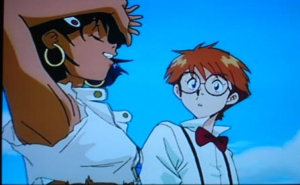 engage the true enemy. The penultimate antagonist is Gargoyle, the embodiment of insensate evil. He leads the Neo-Atlanteans cloaked in attire liking to the Klu Klux Klan meets the Nazis automatically generating a visual distaste for viewers. Gargoyle’s cult of personality is the epitome of a despicable, heartless, icy tactician and despot. He is the true descendant of 12,000-year-old Atlantis not unlike his arch nemesis Nemo. To offset the intense rivalry Nadia is interspersed with a variety of inter-crew relationships. Grandis falls head over heels for Nemo. The triangle is completed by Electra’s jealousies. Jean and Nadia begin to ignite their own romance. Techno-geeks Jean and Hanson explore their own love for invention and gadgetry. Most engaging in the series for adult viewers is the battle of wills that plays out between Nemo [fabulously voiced by Ev Lunning Jr.] and his doppelganger Gargoyle [brilliantly voiced by David Jones]. The episodes encapsulating the dynamic duel make for the very best of the Nadia series’ exploration of good versus evil.
engage the true enemy. The penultimate antagonist is Gargoyle, the embodiment of insensate evil. He leads the Neo-Atlanteans cloaked in attire liking to the Klu Klux Klan meets the Nazis automatically generating a visual distaste for viewers. Gargoyle’s cult of personality is the epitome of a despicable, heartless, icy tactician and despot. He is the true descendant of 12,000-year-old Atlantis not unlike his arch nemesis Nemo. To offset the intense rivalry Nadia is interspersed with a variety of inter-crew relationships. Grandis falls head over heels for Nemo. The triangle is completed by Electra’s jealousies. Jean and Nadia begin to ignite their own romance. Techno-geeks Jean and Hanson explore their own love for invention and gadgetry. Most engaging in the series for adult viewers is the battle of wills that plays out between Nemo [fabulously voiced by Ev Lunning Jr.] and his doppelganger Gargoyle [brilliantly voiced by David Jones]. The episodes encapsulating the dynamic duel make for the very best of the Nadia series’ exploration of good versus evil.
The success of Nadia lies with Gainax and the studio’s ability to infuse their tapestry with rich character escapades and thoughtful themes. Life and death, destiny/ fate, human design, balance [ying yang] between the natural and modern worlds and ultimately good versus evil are all pervasive themes throughout the series. The concept of the old and new is visually reflected in Nadia and Jean’s attire respectively [the primal with exposed mid-riff versus snappy and proper etiquette]. Director Hideaki Anno said it best in Animerica in 2000, “If you describe it with words, it becomes philosophical, but after all, it’s an anime where a girl with a bare midriff gets on a submarine. It can’t be too serious.” But there are moments of religious symbolism and deeper ambition at work that hint to his own grand and apocalyptic aspirations to come for NGE.
Powerhouse Gainax makes another refreshing case with its creative energy. Nadia is a pastiche of 19th Century influence combined with science fiction elements injected into epic storytelling. It is a canvas with a collusion of ideas from the past and future. From the bespectacled gentleman apparel of Jean to Nemo’s sea-worthy captain’s uniform to the elite abbey dress of Grandis, there is much to enjoy here from a design perspective set against tech-heavy backdrops using The Gratan, Nautilus, N-Nautilus, garfish and spaceships. It is a fascinating and odd juxtaposition of elements that works wonders.
The animation is generally solid but is not the company’s strongest effort. Colors are vibrant, but details are surprisingly limited from Gainax. Character and mechanical designs are unforgettably brilliant. The print is
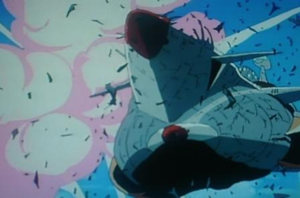 slightly dirty and would benefit from a solid ‘platinum’ styled remix and remaster treatment on sound and vision. Despite these flaws, the colors burst forth in Nadia. As one has come to expect with any studio, the art is deliciously Gainax [most of the time] but there are limitations on fluidity based upon strict use of finite cel numbers. Budgetary considerations definitely impacted the flow of animating. Further, substantial animating was outsourced and the degradation in quality in spots throughout the series is notable. Volume five [Nemo’s Fortress] is a good example of these inconsistencies. The company’s later commitment on NGE and FLCL put some Nadia sequences to shame. So animation is erratic from volume to volume, but when it’s great it’s Gainax. Stock footage is often implemented from episode to episode to cut corners. There are plenty of still shots and cels that lack any real detail to fall within budget and time constraints. There are certainly differing degrees of success with each episode. Episodes range from almost pointless to the perfect mix of drama and action. Each volume is impressively labeled articulately capturing the central themes of each block of shows.
slightly dirty and would benefit from a solid ‘platinum’ styled remix and remaster treatment on sound and vision. Despite these flaws, the colors burst forth in Nadia. As one has come to expect with any studio, the art is deliciously Gainax [most of the time] but there are limitations on fluidity based upon strict use of finite cel numbers. Budgetary considerations definitely impacted the flow of animating. Further, substantial animating was outsourced and the degradation in quality in spots throughout the series is notable. Volume five [Nemo’s Fortress] is a good example of these inconsistencies. The company’s later commitment on NGE and FLCL put some Nadia sequences to shame. So animation is erratic from volume to volume, but when it’s great it’s Gainax. Stock footage is often implemented from episode to episode to cut corners. There are plenty of still shots and cels that lack any real detail to fall within budget and time constraints. There are certainly differing degrees of success with each episode. Episodes range from almost pointless to the perfect mix of drama and action. Each volume is impressively labeled articulately capturing the central themes of each block of shows.
Voice acting is top notch. Ed Lunning, Jr. and David Jones flawlessly betray Nemo and Gargoyle respectively, behaving like two naturally grizzled war veterans. Shawn Sides inserts a star turn in one of the most convincing animal performances to date as King. The lion cub’s comical responses sometimes steal the show combined with the exquisite, deft use of the often-exaggerated Gainax facial animation. Sarah Richardson as Grandis, Jennifer Stuart as Electra, Meg Bauman as Nadia and even the phony French accent of Nathan Parsons as Jean all excel.
Nadia feels like an impossible dream but it works thanks to the dreamers who dreamed it. Nadia, Jean and King board the most amazing underwater submarine in Captain Nemo’s Nautilus, become his ongoing live-in residents; fly in the turtle-shaped power of The Gratan; enter secret bases; witness a talking whale; beam into spaceships; become lost on a floating island which is really a spaceship called Red Noah; battle
 a giant, deadly squid and other creepy sea crawlers while attempting to get rare medicinal herbs deep in the ocean caverns; navigate minefields; flee killer robots; fight fatal fever; eat drug-tripped mushrooms; battle an evil race of gun-toting baddies in the Neo-Atlanteans; meet hostile natives and on and on and on. Try pitching that one at a board meeting today. Will Nadia learn of her connection to the lost civilization of Atlantis and her connection to the mysterious Captain Nemo? What of the fate of Nadia and Jean and their future? Oh, did I mention everyone seems to want this curious little blue stone that hangs around Nadia’s neck called the Blue Water? The blue amulet is clearly the McGuffin of the story, driving viewers toward a rousing conclusion featuring an all out lethal war between Nemo and Gargoyle. But what is the secret of the gem that is the Blue Water? This is the gnawing question at the heart of this emotionally charged anime production. Of course the inevitable fate of the planet hanging in the balance is one small part of it, nothing to be too concerned about really. The Blue Water is the symbol that pushes Nadia to embrace her fate.
a giant, deadly squid and other creepy sea crawlers while attempting to get rare medicinal herbs deep in the ocean caverns; navigate minefields; flee killer robots; fight fatal fever; eat drug-tripped mushrooms; battle an evil race of gun-toting baddies in the Neo-Atlanteans; meet hostile natives and on and on and on. Try pitching that one at a board meeting today. Will Nadia learn of her connection to the lost civilization of Atlantis and her connection to the mysterious Captain Nemo? What of the fate of Nadia and Jean and their future? Oh, did I mention everyone seems to want this curious little blue stone that hangs around Nadia’s neck called the Blue Water? The blue amulet is clearly the McGuffin of the story, driving viewers toward a rousing conclusion featuring an all out lethal war between Nemo and Gargoyle. But what is the secret of the gem that is the Blue Water? This is the gnawing question at the heart of this emotionally charged anime production. Of course the inevitable fate of the planet hanging in the balance is one small part of it, nothing to be too concerned about really. The Blue Water is the symbol that pushes Nadia to embrace her fate.
Nadia concludes with much less ambiguity than Gainax’ ultimate masterwork NGE opting to satiate viewers with a more traditionally tidy and safer finale. It is a gratifying adventure series that also led to a motion picture sequel entitled Nadia Of The Mysterious Seas [aka Nadia: The Secret Of Fuzzy]. The quality assigned to the film sequel is far removed from Gainax’ operational standards. The animation and writing are downright atrocious, as the creative team behind the series had moved on to other endeavors. It was merely a financial decision to squeeze the franchise. Fuzzy wuzzy is no Nadia. The disastrous movie sequel should be avoided. The endearing series remains an enduring, timeless anime classic and one that is often referenced as one of the best. Personally, the series has significant flaws that just don’t hold up as well for me given the compromises that were made to create it. Given its breadth of 39 episodes some believe it to be a remarkable epic that did not make its way to US shores until 2001, a true odyssey. In reality, the epic’s length suffers under its own weight, 26 episodes would have been more effective. It should have been tightly edited to sharpen the delivery of its story; it’s just too damn long. Watching the characters interact, face adversity and meet challenges is a treat and never hits a false note, but at times the filler gets tedious. At the beginning of each episode a narrator would often inquire in one variation or another, “Do you want to know the secret?” There were times half way through I was thinking to myself, “No, I really don’t. Stop already!” But for kids looking for some good, old-fashioned escapist entertainment with loads of heart and soul catch a hot air balloon or a submerging submarine or the flying Gratan and wish upon a shooting star with Nadia for her adventure in self-discovery. So the question remains, do you want to know the secret?
EPISODE GUIDE:
VOLUME 1: THE ADVENTURE BEGINS
Episode 1: The Girl At The Eiffel Tower [B-]
Episode 2: The Little Fugitive [C+]
Episode 3: The Riddle Of The Giant Sea Monsters [B-]
Episode 4: Nautilus, The Fantastic Submarine [B]
VOLUME 2: THE DARK KINGDOM
Episode 5: Marie’s Island [B+]
Episode 6: Infiltration Of The Secret Base [B]
Episode 7: The Tower Of Babel [B]
Episode 8: Mission To Rescue Nadia [A-]
VOLUME 3: ABOARD THE NAUTILUS
Episode 9: Nemo’s Secret [B-]
Episode 10: A Crowning Performance By The Gratan [B]
Episode 11: New Recruits For The Nautilus [C+]
Episode 12: Grandis And Her First Love [C+]
VOLUME 4: BATTLEGROUND
Episode 13: Run Marie Run! [C+]
Episode 14: The Valley Of Dinicthys [C+]
Episode 15: The Nautilus Faces Its Biggest Crisis [B+]
Episode 16: The Mystery Of The Lost Continent [B-]
VOLUME 5: NEMO’S FORTRESS
Episode 17: Jean’s New Invention [C]
Episode 18: Nautilus vs Nautilus [C]
Episode 19: Nemo’s Best Friend [C]
Episode 20: Jean Makes A Mistake [C]
VOLUME 6: THE DEEP BLUE SEA
Episode 21: Farewell Nautilus [A]
Episode 22: Electra The Traitor [A-]
Episode 23: Young Drifters [C-]
Episode 24: Lincoln Island [C]
VOLUME 7: NADIA’S ISLAND
Episode 25: The First Kiss [C-]
Episode 26: King, The Lonely Lion [D]
Episode 27: The Island Of The Witch [F]
Episode 28: The Floating Island [D]
VOLUME 8: THE SECRET CAVE
Episode 29: King vs. King [C-]
Episode 30: Labyrinth In The Earth [C+]
Episode 31: Farewell, Red Noah [B]
Episode 32: Nadia’s Love [C]
VOLUME 9: NADIA IN LOVE
Episode 33: King’s Rescue [C+]
Episode 34: My Darling Nadia [C-]
Episode 35: The Secret Of Blue Water [C]
Episode 36: The New Nautilus [A]
VOLUME 10: THE PROPHECY FULFILLED
Episode 37: Emperor Neo [B]
Episode 38: To The Sky [A]
Episode 39: Successor To The Stars [B+]
CHARACTERS:
JEAN RALTIQUE
NADIA
KING
MARIE
GRANDIS GRANVA
HANSON
SANSON
CAPTAIN NEMO
FIRST OFFICER ELECTRA
GARGOYLE
EMPEROR NEO
AYERTON
THE GRATAN [aka THE GRANDIS TANK]
THE NAUTILUS
THE N-NAUTILUS [THE NEW NAUTILUS]
OTHER WORKS BY HIDEAKI ANNO & GAINAX:
ROYAL SPACE FORCE: WINGS OF HONNEAMISE [1987]
GUNBUSTER [1988]
NEON GENESIS EVANGELION [1995]
FLCL [2000]
THIS UGLY YET BEAUTIFUL WORLD [2004]
GUNBUSTER 2 [aka DIE BUSTER] [2007]
NEON GENESIS EVANGELION REBUILD [2007]
